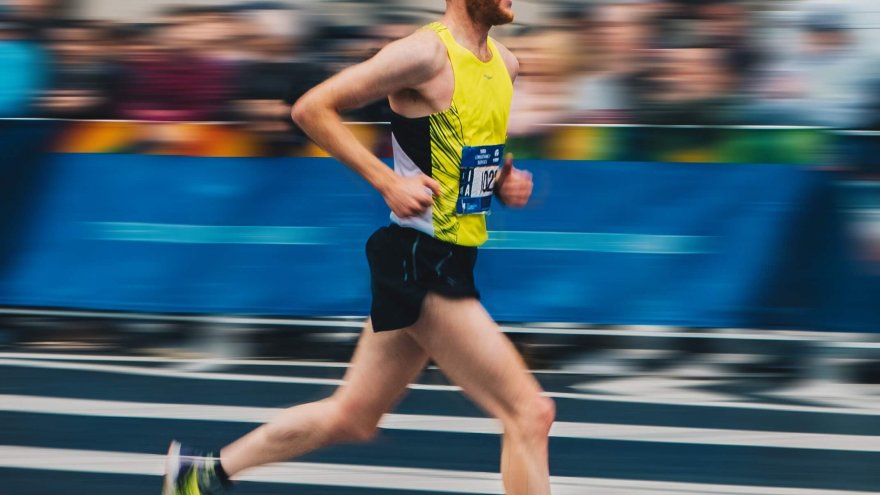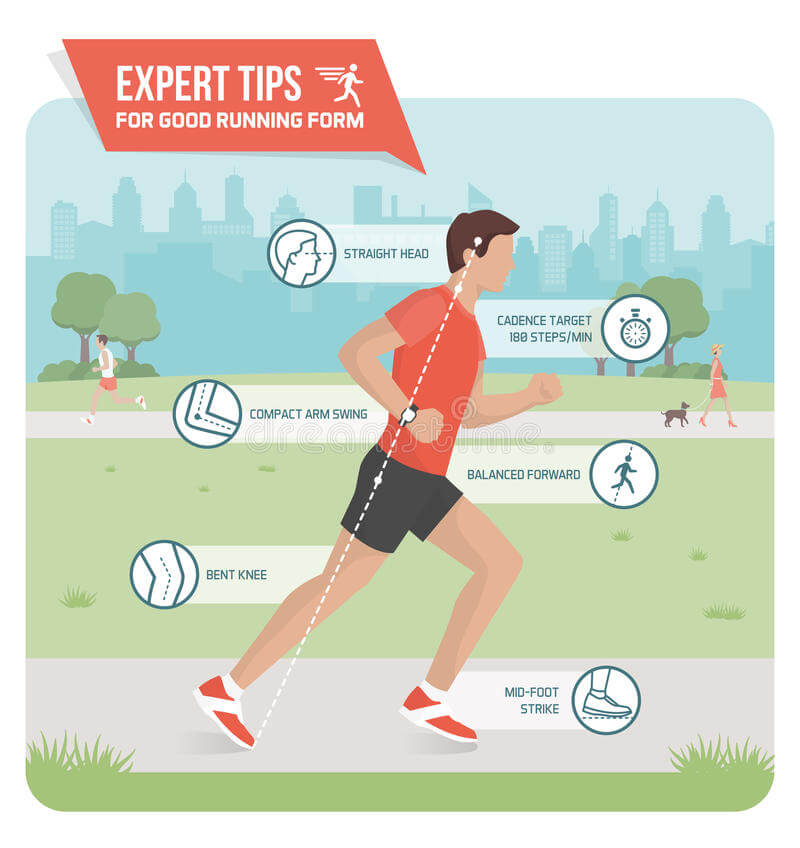Proper Running Form: Easy Step by Step Guide

Using proper running form can help you to run faster and also, in some situations, to remain injury-free.
While you certainly can run without ever paying attention to proper running technique, that does not mean it is unimportant.
Why Is Good Running Form Important?
Let’s start with a discussion of why it is important to have good posture. Learning how to run can help you in many ways. Using the correct form can help you save energy, prevent running injuries, and use your muscles efficiently.
These things could help you to get faster over time.
How Do You Know If Your Running Form is Correct?
A certified running coach or running specialist can analyze your running technique if you want expert advice and correction. What if you don’t have access to someone who is an expert?
You can make a video of yourself running. There are certain things to look for (stay tuned for these!) to see if you are using the correct form.

You should look at your running posture: are you running tall? Are you facing ahead? What about your arms? Don’t cross your arms in front of your body. Also, give some attention to your feet. Are you feeling overwhelmed?
Let’s break it down into small, manageable steps.
Proper Running Form: 6 Things to Pay Attention To
When contemplating the question, “what is proper running form,” there are some simple running tips to follow.
1. Posture: Stand tall, facing forward, with your neck in a neutral position. Look slightly ahead of you (unless you are on a technical trail and need to focus on your footfalls).
2. Focus Ahead: Ideally, you focus anywhere from 10-20 feet ahead of you.
3. Arm Swing: Think about your arm swing. Don’t let your arms cross in front of your body, which often happens as we fatigue. Keep your elbow bent at a 90-degree angle and use a full arm swing. Your arm should swing from your “back pocket” to chest height while staying near your side.
4. Hips: When running, lead with your hips. Core strength is key to this concept.
5. Feet: Although there are many different types of foot strike out there, a mid-foot strike is considered ideal for most runners. If you are going to modify your strike and the way your foot lands (like a forefoot strike or heel-striking), this is a good goal.
6. Listen to Your Body: Does anything hurt? It could be many things contributing to the discomfort. Just be certain to listen to what your body is telling you in order to avoid injury risks.
3 Signs of Bad Running Form
Signs of a bad running form include:
- pain
- recurring muscle soreness
- inefficient arm swinging
Pain in different parts of the body can point to specific mechanical issues. Running with a correct running form can help alleviate back and neck pain.
It is important to recognize that other things can contribute to specific types of running pain. For example, knee or shin pain could be an issue of not having the correct running shoes.
Although it is great to be reflective regarding running form tips and figuring out how to run properly, it is just as important to be sure you have the basics covered.
A good quality running shoe is like the foundation of a house. Start with a solid foundation to find success.
What Are The Most Common Errors in Running?
Hands down, the most common error I see as a coach is beginners running with their arms crossing in front of their bodies. This is not an efficient way to run.
The second common error is running too tense. It is important to relax your body. This means everything from your shoulders to your hands to your face.
If you think you are running with too tense of a face, try a trick I used on my track athletes. Run with two Pringles in your mouth, making a duck’s beak. If they break, you are running too tense. Sure, you will look ridiculous… but you will be forced not to tighten up – (Note: this is way more fun to do with a running buddy).
An unrelaxed upper body can cause shoulder and neck pain and is another common mistake newbies make.
Many coaches would say that running with a slow cadence is a mistake, but I don’t see it this way. When you start out running, you have to start somewhere. If you worry too much about a certain cadence or leg turnover, you could find yourself getting discouraged.
I believe the number one mistake new runners make has nothing to do with form: they try to do too much, too soon. This can lead to frustration, and the person ends up just giving up. Do not fall victim to this.
Runnerclick Pro Coaches Weigh In
We asked our RunnerClick Pro coaches to share some advice on how to achieve proper running form.
Coach Carrie Miller of On Pace Coaching has this advice, “In simple terms, here are what I feel are the keys to proper running form.”
- Slight lean forward of the upper body, shoulders down and back.
- Relaxed arm swing that doesn’t cross in front of your body (think of brushing up against your pockets as you swing).
- Midfoot strike under your body (for longer distance running, not sprinting).
- Feet that stay slightly apart (sideways) as you step – think of and practice placing each foot on opposite sides of the white line on the side of the road. Feet should have neutral pronation.
Lauren Sheu of Running for Wellness also has some sound advice for us.
1. Relax your shoulders and arms. Do not clench or slump your shoulders, make sure they feel loose and relaxed.
2. Look straight ahead when you run. Keep your head forward and try to avoid looking down.
3. Maintain good posture as you run. Stand straight up and engage your core. Lean slightly forward.
4. Keep your hands loose. It should feel like you’re loosely holding an egg with each hand.
5. Use a relaxed arm swing and maintain a 90-degree angle bend at your elbows. Do not cross your arms in front of you. Imagine that there is a divider going down your center.
Your hands should not cross that line to the other side of your body. Also, try to avoid rotating your body as you run. Face forward in the direction you are running.
6. Take short and light steps. Aim for a cadence of 180 steps per minute.
Chris Bailey, Director and Coach, Without Limits Charleston, adds the following.
These increases, however, require more energy. Improvements to our running form can lead to enhanced running economy, which is our body’s ability to utilize energy, especially oxygen, efficiently.
Enhanced running economy allows us to increase our stride length or stride frequency without requiring more energy. If I were to have athletes focus on one change, it would be to increase their cadence or stride rate/frequency.
Many common issues with form, such as poor posture, overstriding, and heel striking can be resolved by having athletes increase their cadence by focusing on shorter, quicker strides. Athletes can track their cadence using devices like certain GPS watches or by using a metronome.
At the End of the Day, How Much Does Form Matter?
In your quest to figure out the best way to run, you will find yourself focusing on everything from a correct running posture to proper foot striking. Wondering why we give you similar advice from two separate running coaches? Great question.
It is because sometimes how someone phrases something really resonates with a runner. It is part of why we all learn differently.
Whether the question in your head is how to get faster at running or is this the best way to run, one thing remains true: no matter how you run – it is good for your body.
We all have to walk before running and running slowly before we sprint. Be patient with yourself and give yourself grace. Study running, but don’t overthink it.
Just find joy in moving your body, friends.
Latest Articles
 Is Running on a Treadmill Easier Than Running Outside?Runners have their own preferences, whether it is treadmill running, running outside on the road, or exploring trails. So...
Is Running on a Treadmill Easier Than Running Outside?Runners have their own preferences, whether it is treadmill running, running outside on the road, or exploring trails. So... Is It OK to Use Trail Running Shoes on the Road?While trail running shoes can be used on roads, especially in situations where a runner encounters mixed terrains or pref...
Is It OK to Use Trail Running Shoes on the Road?While trail running shoes can be used on roads, especially in situations where a runner encounters mixed terrains or pref... How to Fix Sore Quads After Running?Rest, ice, gentle stretching, and over-the-counter pain relievers can help soothe sore quads after running. Also, ensure ...
How to Fix Sore Quads After Running?Rest, ice, gentle stretching, and over-the-counter pain relievers can help soothe sore quads after running. Also, ensure ... 10 Fruits With The Most Electrolytes to Replace Sports DrinksThese fruits are high in electrolytes such as potassium, magnesium, and calcium, essential for hydration, muscle function...
10 Fruits With The Most Electrolytes to Replace Sports DrinksThese fruits are high in electrolytes such as potassium, magnesium, and calcium, essential for hydration, muscle function...

